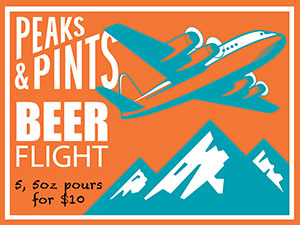 The Pacific Northwest has a hop obsession. At any brewery, in any bar, you’re likely to encounter the devout disciples of the bitter plant, known as hopheads, guzzling the latest hopped-up brew. Without doubt, beers like IPAs and Double IPAs (DIPA) are the quintessential Northwest beers. But believe it or not, a hop, now one of the four main ingredients of beer, has not always been the shining star of the brew. It wasn’t until the 13th Century, back when Belgium and the Netherlands were still called the “Low Countries” [Editor’s note: They still kind of are, nether-land], that hops were finally introduced to beer, supplanting now less popular flavorants such as saffron, honey, grapes and wormwood. The practice of adding flavor ingredients to a batch of beer has more or less created the craft beer industry. Brewers play with different fruits, tap into spices from different cultures and experiment with a variety of hops species because, why not? Some hop varietals are so new, they are only known by numbers, but they just might be the next big thing in beer (à la Mosaic). Not only do experimental hops allow for flexibility, but also as certain experimental hops become the next big mainstream hop, they allow for breeders to identify what characteristics brewers are looking for and tailor their genetic programs accordingly. Peaks and Pints experiments with an experiment hop beer flight today, offering five beers brewed with experimental hops in what we call Craft Beer Crosscut 5.18.18: A Flight of Experimental Hops.
The Pacific Northwest has a hop obsession. At any brewery, in any bar, you’re likely to encounter the devout disciples of the bitter plant, known as hopheads, guzzling the latest hopped-up brew. Without doubt, beers like IPAs and Double IPAs (DIPA) are the quintessential Northwest beers. But believe it or not, a hop, now one of the four main ingredients of beer, has not always been the shining star of the brew. It wasn’t until the 13th Century, back when Belgium and the Netherlands were still called the “Low Countries” [Editor’s note: They still kind of are, nether-land], that hops were finally introduced to beer, supplanting now less popular flavorants such as saffron, honey, grapes and wormwood. The practice of adding flavor ingredients to a batch of beer has more or less created the craft beer industry. Brewers play with different fruits, tap into spices from different cultures and experiment with a variety of hops species because, why not? Some hop varietals are so new, they are only known by numbers, but they just might be the next big thing in beer (à la Mosaic). Not only do experimental hops allow for flexibility, but also as certain experimental hops become the next big mainstream hop, they allow for breeders to identify what characteristics brewers are looking for and tailor their genetic programs accordingly. Peaks and Pints experiments with an experiment hop beer flight today, offering five beers brewed with experimental hops in what we call Craft Beer Crosscut 5.18.18: A Flight of Experimental Hops.
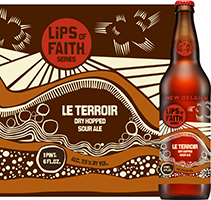 New Belgium Le Terroir
New Belgium Le Terroir
7.5% ABV, 12 IBU
Le Terroir is a French term meaning ‘of the earth’ and is frequently used to reference the natural, environmental conditions that affect beer. So it is with New Belgium Brewing‘s Wood Cellar and the foeders in which Le Terroir is created. These oak barrels combine nature and craftsmanship to age our sour beer in varying temperatures, humidity and vibrations. Coupled with dry-hopping using fruit-forward Nugget and Amarillo hops and Experimental 522 hop, Le Terroir is golden-colored with a soft overripe peach aroma and just the right amount of tart. And after three years in the foeders, you can bet it has some nice earthy tones.
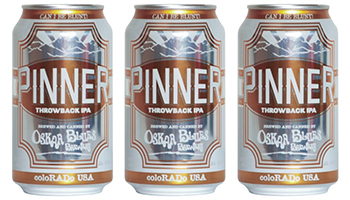 Oskar Blues Pinner Throwback IPA
Oskar Blues Pinner Throwback IPA
4.9% ABV, 35 IBU
Oskar Blues threw “throwback” on Pinner’s name for two reasons — the beer has some elements of an old-school IPA heavy on hops and lighter in ABV, which in turn makes it easier to throw a few back. The Longmont, Colorado brewery is primarily known for its high ABV offerings, but this session IPA complements those nicely. For Pinner, Oskar Blues tosses in six to eight different hops per batch — including an experimental variety — then dry-hopped with Mosaic, Citra, Eldorado and Azacca hops, for tropical fruits, citrus juices, pineapple and spice berry up front, balanced with biscuit and toasted bread in the back.
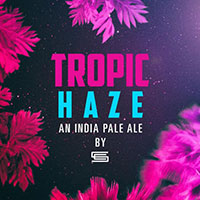 Silver City Tropic Haze
Silver City Tropic Haze
6.4% ABV, 50 IBU
This beer spent some time in test tubes. Silver City Brewery Brewmaster Don “Big Hazy” Spencer opened up the secret experimental hop hope chest, brewed pilot batch after pilot batch, blind-tasted close friends and discovered a secret hop made for hazy IPAs. No, the pineapple juice, mango or orange flavors aren’t additives; it’s the secretive experimental hop behind the curtain. Tropical, indeed. Juicy tropical fruit, but not sweet and overpowering. Just the right amount.
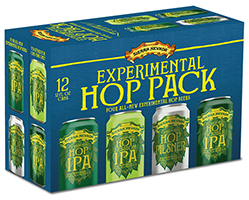 Sierra Nevada Experimental Hops
Sierra Nevada Experimental Hops
ABV varies, IBUs vary
Peaks and Pints cracked open Sierra Nevada Experimental Hop Pack for today’s beer flight. The variety pack features four different beers brewed with experimental hops — most don’t have names yet, they have numbers. The Experimental Hop Pilsner is about 5.4 percent ABV. The pilsner is crisp with traditional grassy flavors from the hops. The hops also give it a honey-like flavor with a hint of spice in the finish. The Experimental Double IPA is citrusy and piney. The hops used are supposed to give the beer a barrel-aged quality, but we get a hint of vanilla-like oakiness. Despite that, the beer is excellent. The Experimental Hop IPA is fine. The Experimental Hop Session IPA is extremely light. If you drink any beer before that one, it will feel like you’re drinking water. See if you can distinguish the one we pour your today.
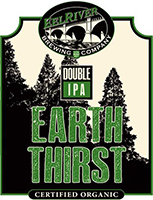 Eel River Earth Thirst
Eel River Earth Thirst
8.2% ABV, 71 IBU
Eel River Brewing’s seasonal double IPA Earth Thirst was brewed in celebration of our planet and in support of organic farming. Light, warm malt flavors are purposely dominated by a massive dose of the pungent, floral, and citrus-like characteristics of Pacific Northwest organic hops-including X117 — an experimental hop developed and grown by the Oregon Hophouse. The aroma is somewhat reserved for the style, lighter and with pine, white grape and white peach, swirling in a rarefied airiness. In contrast, the taste is heavier. Alcohol makes itself known from the very beginning of the sip and becomes more assertive through the aftertaste. Pear and white grape juice moderate some of the alcohol’s brusque appearance. The hop profile is also understated, lifted a little by the carbonation, but still somewhat suppressed by the raw alcohol taste.
